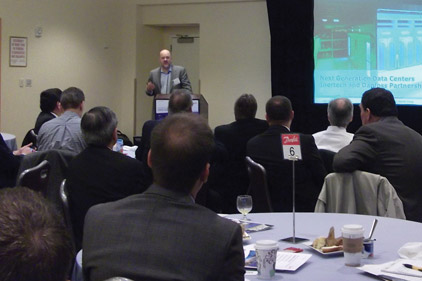NEW YORK — Danfoss hosted its 19th annual press briefing during the 2014 AHR Expo. This year’s press briefing included discussions of key trends, challenges, and opportunities impacting the HVACR industry, as well as two customer presentations. “Danfoss is uniquely positioned to support a transition period in climate change and energy efficiency,” said John Galyen, president, Danfoss North America.

|
| Jakob Carnemark, CEO, Aligned Energy, speaks during the Danfoss press briefing at the 2014 AHR Expo. |
Galyen opened by discussing three megatrends impacting industry: energy productivity, data, and refrigerants. He noted that the focus on energy productivity must include two components — efficiency and demand response, the latter of which is becoming increasingly important. He also discussed the proven technologies, like variable-speed compressors and advanced supermarket controls, that can support performance, efficiency, and energy productivity.
Jakob Carnemark, CEO, Aligned Energy, presented a unique approach to address the growing cooling needs in critical data center applications.
“Data centers are super critical applications, where uptime and reliability are paramount, and the cost and availability of power also are important,” said Galyen, who also noted that advances in data acquisition are poised to revolutionize the industry. Nearly 50 percent of data center upkeep costs can be attributed to cooling needs and will, therefore, transform the demands on the HVACR industry for continual, improved performance.
While discussing the third megatrend, Galyen reminded attendees that the refrigerants issue is a global issue in need of a global solution. Jeff Staub, application engineering manager, Danfoss, addressed the changing and complex refrigerant landscape and elaborated on the clear industry trend toward a global phasedown of hydrofluorocarbons (HFCs).
Staub said, “There is no single refrigerant that fits all applications.”
The choice of refrigerant will depend on the application, regulations, regional variations, and educational level of the service sector — especially in the development of low-global warming potential (GWP) solutions.
For this reason, Danfoss is focused on four future development activities regarding low-GWP refrigerants: staying ahead of CO2; improving material development and compatibility for new refrigerants and oils; improving component designs to better fit changing applications by implementing a variety of capacity-based testing for both synthetic and natural refrigerants; and increasing application testing by adding additional climate chambers or developing new climate chambers that control more variables at a variety of different levels.
“The key,” Staub said, “is working with customers to understand their various applications, and therefore understand how to increase efficiency. To do this, one also needs to understand specific refrigerant.”
Galyen closed the press briefing by noting that Danfoss continues to focus on “helping customers meet individual challenges, while meeting industry guidelines for regulations.” It is a delicate balance, but one that can be achieved with education and the right application, he said.
Publication date: 2/17/2014
Want more HVAC industry news and information? Join The NEWS on Facebook, Twitter, and LinkedIn today!









